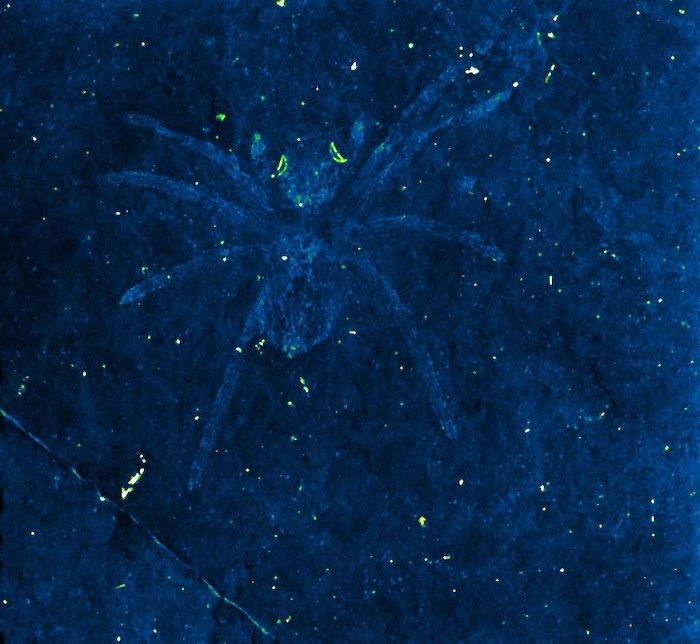
Credit: Paul Selden
LAWRENCE — Usually, soft-bodied species like spiders aren’t fossilized in rock like animals with bones and teeth. More often, ancient spiders and insects are more likely to be discovered preserved in amber.
Yet a new paper in the Journal of Systematic Palaeontology, co-written by a University of Kansas researcher, describes fossil spiders found in an area of Korean shale called the Lower Cretaceous Jinju Formation.
What’s most remarkable: Two of the fossils from the extinct spider family Lagonomegopidae feature reflective eyes that enabled their nighttime hunting.
“Because these spiders were preserved in strange slivery flecks on dark rock, what was immediately obvious was their rather large eyes brightly marked with crescentic features,” said Paul Selden, Gulf-Hedberg Distinguished Professor of Geology and director of the Paleontological Institute at KU’s Biodiversity Institute and Natural History Museum. “I realized this must have been the tapetum — that’s a reflective structure in an inverted eye where light comes in and is reverted back into retina cells. This is unlike a straightforward eye where light goes through and doesn’t have a reflective characteristic.”
Selden said that some contemporary spiders feature eyes with a tapetum, but the new paper is the first to describe the anatomical feature in a fossilized spider. The research team said the discovery provides evidence for lagonomegopid enlarged eyes being posterior medians.
“ln spiders, the ones you see with really big eyes are jumping spiders, but their eyes are regular eyes — whereas wolf spiders at nighttime, you see their eyes reflected in light like cats,” he said. “So, night-hunting predators tend to use this different kind of eye. This was the first time a tapetum had been in found in fossil. This tapetum was canoe-shaped — it looks a bit like a Canadian canoe. That will help us place this group of spiders among other families.”
Selden’s collaborators were Tae-Yoon Park of the Korea Polar Research Institute and amateur fossil hunter Kye-Soo Nam of the Daejeon Science High School for the Gifted, who found the fossils preserved in the shale.
The description of the fossils boosts the number of known spiders from the Jinju Formation from one to 11. The KU researcher said the spiders, who lived between 110 and 113 million years ago, must somehow have been protected from deterioration to have become so well-preserved in the shale formation.
“This is so rare because they’re very soft — they don’t have hard shells so they very easily decay,” Selden said. “It has to be a very special situation where they were washed into a body of water. Normally, they’d float. But here, they sunk, and that kept them away from decaying bacteria — it may have been a low-oxygen condition. These rocks also are covered in little crustaceans and fish, so there maybe was some catastrophic event like an algal bloom that trapped them in a mucus mat and sunk them — but that’s conjecture. We don’t really know what caused this, but something killed off a lot of animals around the lake at one time or on an annual basis.”
The discovery was made possible because of the unique geography of South Korea, where the shale containing the fossils was exposed during a construction project.
“It’s all black shale, and in that area it’s very hilly,” Selden said. “South Korea doesn’t have much flat land to build anything. So, they carve away the hillsides to make a flat area, and there are temporary excavations while they’re cutting away and building a factory or whatever — that’s where they found these fossils.”
According to Selden, the shale preserved the spider fossils in a manner that highlighted the reflectivity of the tapetum, a feature that may have been missed had the spiders been preserved in amber instead, as is more typical.
“Amber fossils are beautiful, they look wonderful, but they preserve things in a different way,” he said. “Now, we want to go back and look at the amber fossils and see if we can find the tapetum, which stares out at you from rock fossils but isn’t so obvious in amber ones because the mode of preservation is so different.”
Beyond the novelty of discovering the first fossilized-spider tapetum, Selden said the spiders informed the scientific understanding of Cretaceous biodiversity.
“This is an extinct family of spiders that were clearly very common in the Cretaceous and were occupying niches now occupied by jumping spiders that didn’t evolve until later,” he said. “But these spiders were doing things differently. Their eye structure is different from jumping spiders. It’s nice to have exceptionally well-preserved features of internal anatomy like eye structure. It’s really not often you get something like that preserved in a fossil.”
###
Media Contact
Brendan M. Lynch
[email protected]
785-864-8855
Original Source
http://news.
Related Journal Article
http://dx.




